seats MERCEDES-BENZ GL-Class 2013 X166 Owner's Manual
[x] Cancel search | Manufacturer: MERCEDES-BENZ, Model Year: 2013, Model line: GL-Class, Model: MERCEDES-BENZ GL-Class 2013 X166Pages: 454, PDF Size: 6.31 MB
Page 5 of 454
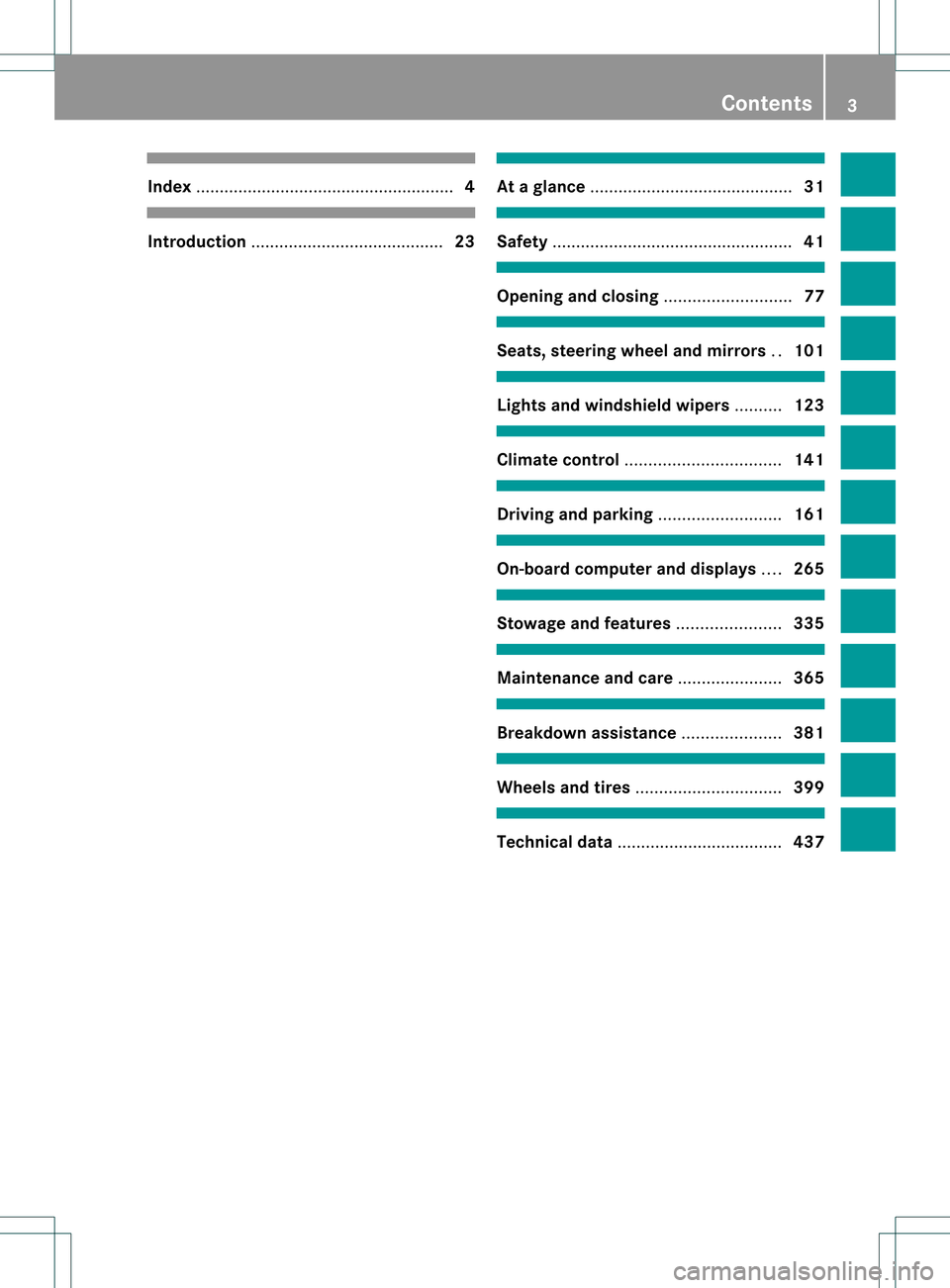
Index
....................................................... 4Introduction
......................................... 23 At
ag lance ........................................... 31 Safety
................................................... 41 Opening and closing
...........................77 Seats, steering wheel and mirrors
..101 Lights and windshield wipers
..........123 Climate control
................................. 141 Driving and parking
..........................161 On-board computer and displays
....265 Stowage and features
......................335 Maintenance and care
......................365 Breakdown assistance
.....................381 Wheels and tires
............................... 399 Technical data
................................... 437 Contents
3
Page 10 of 454
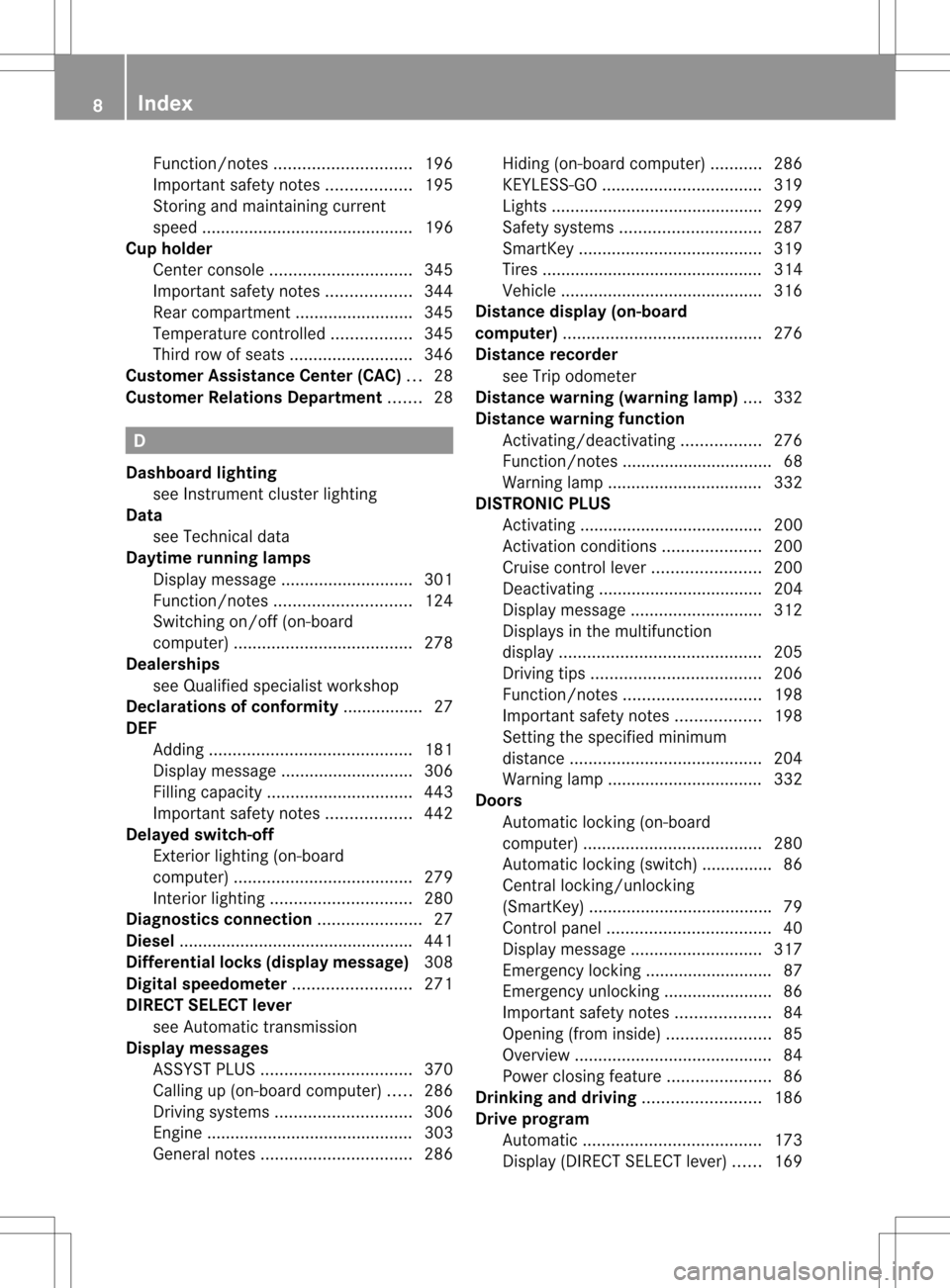
Function/notes
............................. 196
Important safety notes ..................195
Storing and maintaining current
spee d............................................. 196
Cu p holder
Center console .............................. 345
Important safety notes ..................344
Rea rcompartmen t......................... 345
Temperature controlle d................. 345
Third row of seats ..........................346
Customer Assistance Center (CAC) ...28
Customer Relations Department .......28 D
Dashboard lighting see Instrument cluster lighting
Data
see Technical data
Daytime running lamps
Display message ............................ 301
Function/notes ............................. 124
Switching on/off (on-board
computer) ...................................... 278
Dealerships
see Qualified specialist workshop
Declarations of conformity ................. 27
DEF Adding ........................................... 181
Display message ............................ 306
Filling capacity ............................... 443
Important safety notes ..................442
Delaye dswitch-off
Exterio rlighting (on-board
computer )...................................... 279
Interior lighting .............................. 280
Diagnostics connection ......................27
Diesel ................................................. .441
Differential locks (display message) 308
Digital speedometer .........................271
DIREC TSELECT lever
see Automatic transmission
Display messages
ASSYS TPLUS ................................ 370
Calling up (on-board computer) .....286
Driving systems ............................. 306
Engine ............................................ 303
General notes ................................ 286Hiding (on-board computer)
...........286
KEYLESS-GO .................................. 319
Lights ............................................ .299
Safety systems .............................. 287
SmartKey ....................................... 319
Tires ............................................... 314
Vehicle .......................................... .316
Distance display (on-board
computer) .......................................... 276
Distance recorder see Trip odometer
Distance warning (warning lamp) ....332
Distance warning function Activating/deactivating .................276
Function/notes ................................ 68
Warning lamp ................................. 332
DISTRONIC PLUS
Activating ....................................... 200
Activation conditions .....................200
Cruise control leve r....................... 200
Deactivating ................................... 204
Display message ............................ 312
Displays in the multifunction
displa y........................................... 205
Driving tips .................................... 206
Function/notes ............................. 198
Important safety notes ..................198
Setting the specified minimum
distance ......................................... 204
Warning lamp ................................. 332
Doors
Automatic locking (on-board
computer) ...................................... 280
Automatic locking (switch) .............. .86
Central locking/unlocking
(SmartKey) ...................................... .79
Control panel ................................... 40
Display message ............................ 317
Emergency locking ........................... 87
Emergency unlocking .......................86
Important safety notes ....................84
Opening (from inside) ......................85
Overview .......................................... 84
Power closing feature ......................86
Drinking and driving .........................186
Drive program Automatic ...................................... 173
Display (DIRECT SELECT lever) ......169 8
Index
Page 17 of 454
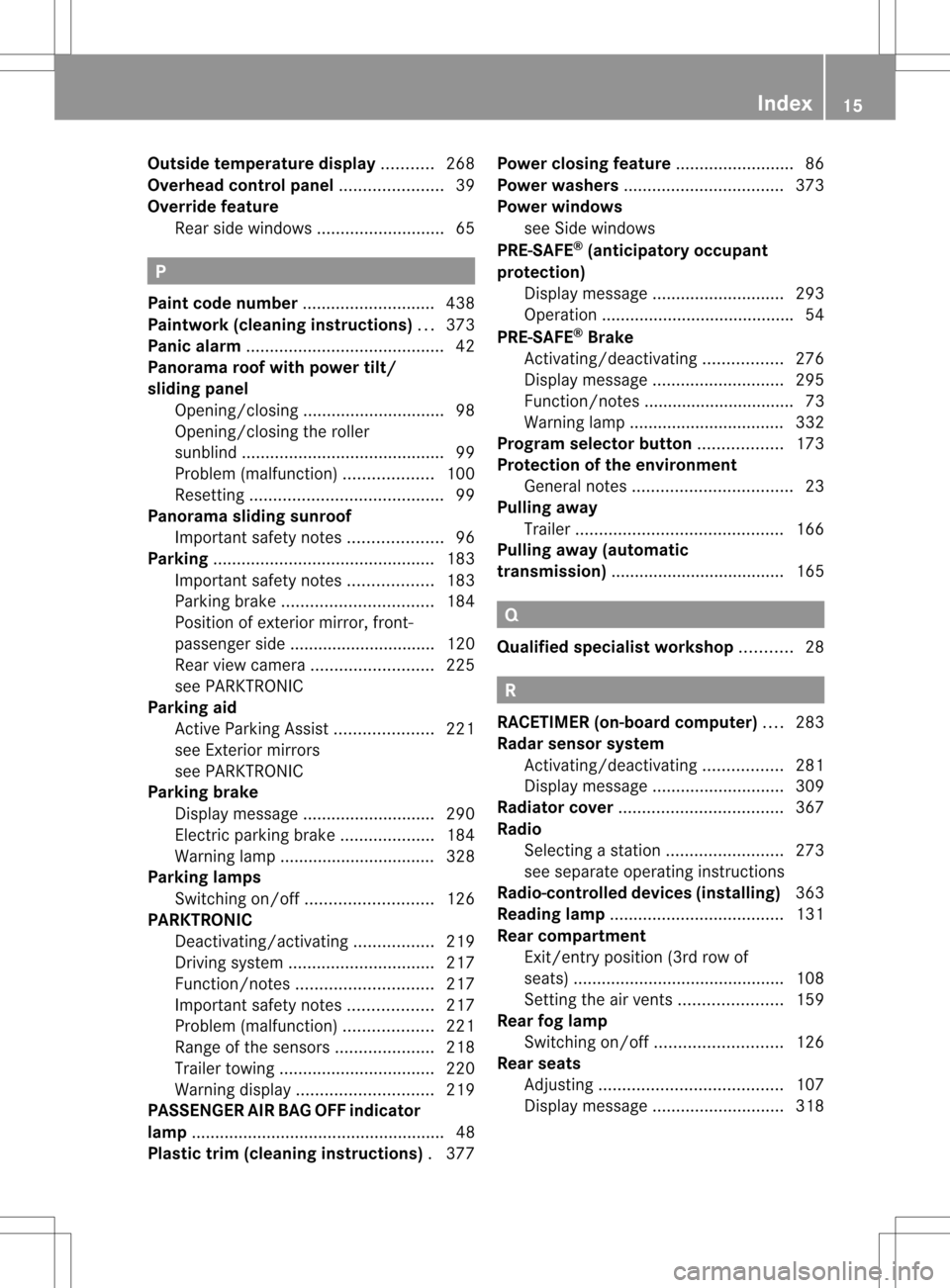
Outside temperature display
...........268
Overhead control panel ......................39
Override feature Rea rside windows ........................... 65 P
Pain tcode number ............................ 438
Paintwork (cleaning instructions) ...373
Panic alarm .......................................... 42
Panorama roof with power tilt/
sliding panel
Opening/closing .............................. 98
Opening/closing the roller
sunblind ........................................... 99
Problem (malfunction) ...................100
Resetting ......................................... 99
Panorama sliding sunroof
Important safety notes ....................96
Parking ............................................... 183
Important safety notes ..................183
Parking brake ................................ 184
Position of exterior mirror, front-
passenger side ............................... 120
Rea rview camera .......................... 225
see PARKTRONIC
Parking aid
Active Parking Assist .....................221
see Exterior mirrors
see PARKTRONIC
Parking brake
Display message ............................ 290
Electric parking brake ....................184
Warning lamp ................................. 328
Parking lamps
Switching on/off ........................... 126
PARKTRONIC
Deactivating/activating .................219
Driving system ............................... 217
Function/notes ............................. 217
Important safety notes ..................217
Problem (malfunction) ...................221
Range of the sensors .....................218
Trailer towing ................................. 220
Warning displa y............................. 219
PASSENGE RAIR BAG OFF indicator
lamp ...................................................... 48
Plastic trim (cleaning instructions) .377 Power closing feature
.........................86
Power washers .................................. 373
Power windows see Side windows
PRE-SAFE ®
(anticipatory occupant
protection) Display message ............................ 293
Operation ........................................ .54
PRE-SAFE ®
Brake
Activating/deactivating .................276
Display message ............................ 295
Function/notes ................................ 73
Warning lamp ................................. 332
Program selector button ..................173
Protection of the environment General notes .................................. 23
Pulling away
Trailer ............................................ 166
Pulling away (automatic
transmission) ..................................... 165 Q
Qualifie dspecialis tworkshop ...........28 R
RACETIMER (on-board computer) ....283
Radar sensor system Activating/deactivating .................281
Display message ............................ 309
Radiator cover ................................... 367
Radio Selecting astation ......................... 273
see separate operating instructions
Radio-controlled devices (installing) 363
Reading lamp ..................................... 131
Rear compartment Exit/entry position (3rd row of
seats) ............................................ .108
Setting the airv ents...................... 159
Rear fog lamp
Switching on/off ........................... 126
Rear seats
Adjusting ....................................... 107
Display message ............................ 318 Index
15
Page 18 of 454
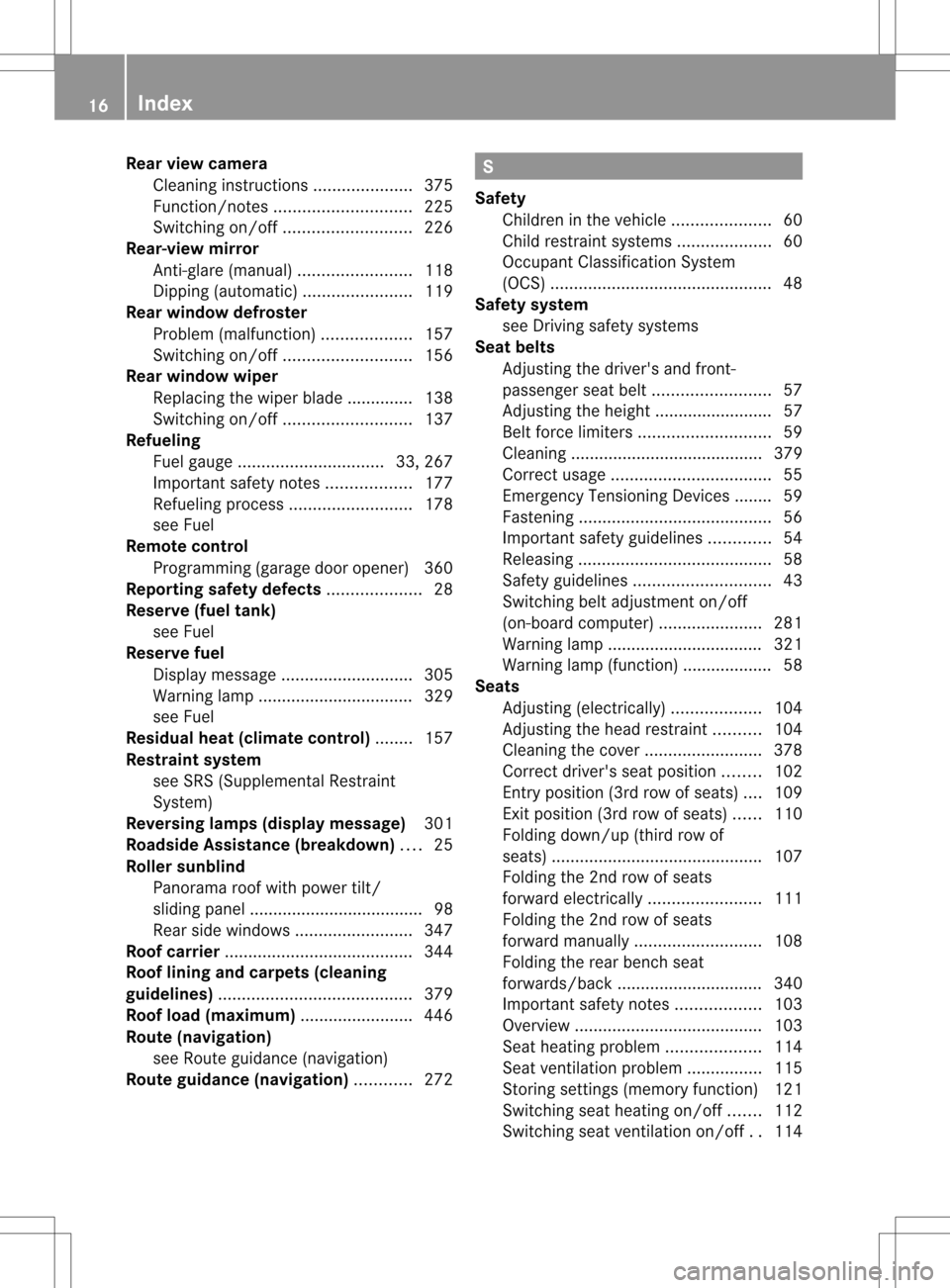
Rear view camera
Cleaning instructions .....................375
Function/notes ............................. 225
Switching on/off ........................... 226
Rear-view mirror
Anti-glare (manual )........................ 118
Dipping (automatic) .......................119
Rear window defroster
Problem (malfunction) ...................157
Switching on/off ........................... 156
Rear window wiper
Replacing the wiper blade .............. 138
Switching on/off ........................... 137
Refueling
Fuel gauge ............................... 33, 267
Important safety notes ..................177
Refueling proces s.......................... 178
see Fuel
Remote control
Programming (garage door opener) 360
Reporting safety defects ....................28
Reserve (fuel tank) see Fuel
Reserve fuel
Display message ............................ 305
Warning lamp ................................. 329
see Fuel
Residual heat (climate control) ........157
Restraint system see SRS (Supplemental Restraint
System)
Reversing lamps (display message) 301
Roadside Assistance (breakdown) ....25
Roller sunblind Panorama roof with power tilt/
sliding panel ..................................... 98
Rea rside windows ......................... 347
Roof carrier ........................................ 344
Roof lining and carpets (cleaning
guidelines) ......................................... 379
Roof load (maximum) ........................446
Route (navigation) see Route guidance (navigation)
Route guidance (navigation) ............272 S
Safety Childre ninthe vehicle ..................... 60
Child restraint systems ....................60
Occupant Classification System
(OCS) ............................................... 48
Safety system
see Driving safety systems
Seat belts
Adjusting the driver's and front-
passenger sea tbelt ......................... 57
Adjusting the height ......................... 57
Belt force limiters ............................ 59
Cleaning ......................................... 379
Correct usage .................................. 55
Emergency Tensioning Devices ....... .59
Fastening ......................................... 56
Important safety guidelines .............54
Releasing ......................................... 58
Safety guidelines ............................. 43
Switching belt adjustment on/off
(on-board computer) ......................281
Warning lamp ................................. 321
Warning lamp (function) ................... 58
Seats
Adjusting (electrically). ..................104
Adjusting the head restraint ..........104
Cleaning the cover .........................378
Correct driver's sea tposition ........102
Entry position (3rd row of seats) ....109
Exit position (3rd row of seats) ......110
Folding down/up (third row of
seats) ............................................ .107
Folding the 2nd row of seats
forward electrically ........................111
Folding the 2nd row of seats
forward manually ........................... 108
Folding the rear bench seat
forwards/back ............................... 340
Important safety notes ..................103
Overview ........................................ 103
Seat heating problem ....................114
Seat ventilation problem ................115
Storing settings (memory function) 121
Switching sea theating on/off .......112
Switching seat ventilation on/off ..114 16
Index
Page 25 of 454
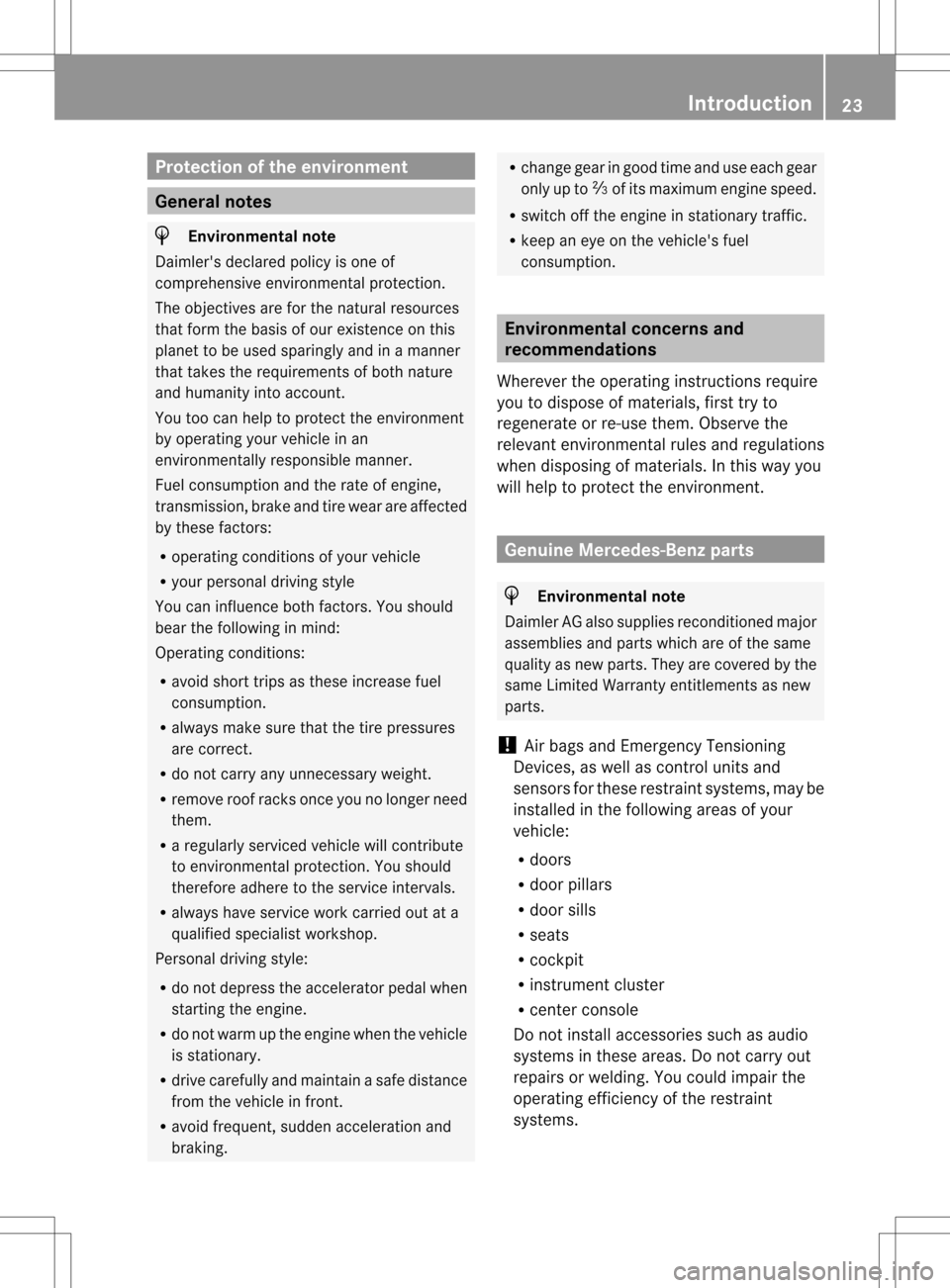
Protection of the environment
General notes
H
Environmental note
Daimler's declared policy is one of
comprehensive environmental protection.
The objectives are for the natural resources
that form the basis of our existence on this
planet to be used sparingly and in a manner
that takes the requirements of both nature
and humanity into account.
You too can help to protect the environment
by operating your vehicle in an
environmentally responsible manner.
Fuel consumption and the rate of engine,
transmission, brake and tire wear are affected
by these factors:
R operating conditions of your vehicle
R your personal driving style
You can influence both factors. You should
bear the following in mind:
Operating conditions:
R avoid short trips as these increase fuel
consumption.
R always make sure that the tire pressures
are correct.
R do not carry any unnecessary weight.
R remove roof racks once you no longer need
them.
R a regularly serviced vehicle will contribute
to environmental protection. You should
therefore adhere to the service intervals.
R always have service work carried out at a
qualified specialist workshop.
Personal driving style:
R do not depress the accelerator pedal when
starting the engine.
R do not warm up the engine when the vehicle
is stationary.
R drive carefully and maintain a safe distance
from the vehicle in front.
R avoid frequent, sudden acceleration and
braking. R
change gear in good time and use each gear
only up to 0001of its maximum engine speed.
R switch off the engine in stationary traffic.
R keep an eye on the vehicle's fuel
consumption. Environmental concerns and
recommendations
Wherever the operating instructions require
you to dispose of materials, first try to
regenerate or re-use them. Observe the
relevant environmental rules and regulations
when disposing of materials. In this way you
will help to protect the environment. Genuine Mercedes-Benz parts
H
Environmental note
Daimler AG also supplies reconditioned major
assemblies and parts which are of the same
quality as new parts. They are covered by the
same Limited Warranty entitlements as new
parts.
! Air bags and Emergency Tensioning
Devices, as well as control units and
sensors for these restraint systems, may be
installed in the following areas of your
vehicle:
R doors
R door pillars
R door sills
R seats
R cockpit
R instrument cluster
R center console
Do not install accessories such as audio
systems in these areas. Do not carry out
repairs or welding. You could impair the
operating efficiency of the restraint
systems. Introduction
23 Z
Page 42 of 454
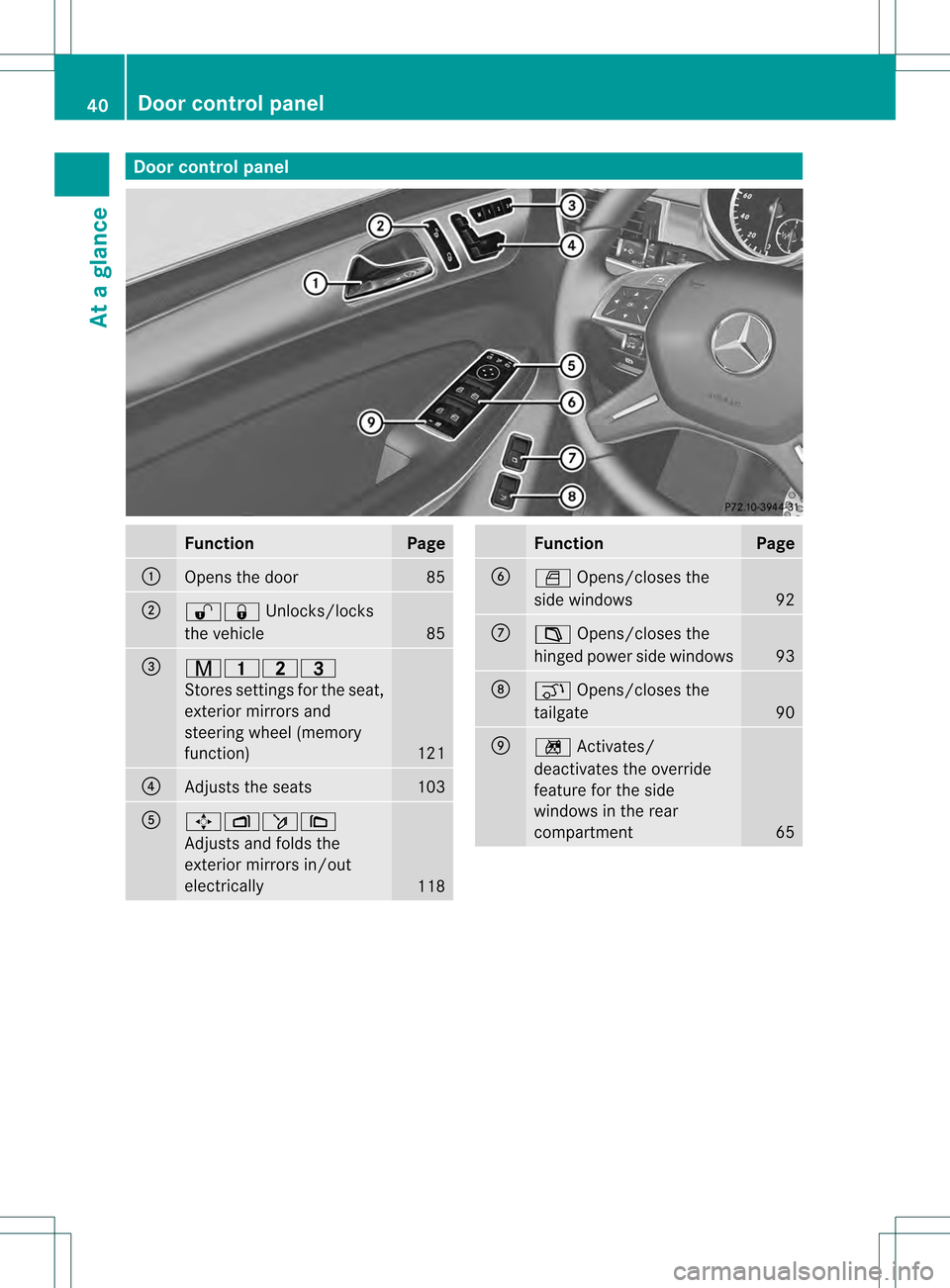
Door control panel
Function Page
0002
Opens the door 85
0003
000D000C
Unlocks/locks
the vehicle 85
0021
00110014000E
Stores settings fo
rthe seat,
exterior mirrors and
steering wheel (memory
function) 121
0020
Adjusts the seats 103
001E
000500090011000A
Adjusts and folds the
exterior mirrors in/out
electrically
118 Function Page
001F
0005
Opens/closes the
side windows 92
0013
0014
Opens/closes the
hinged power side windows 93
0014
0010
Opens/closes the
tailgate 90
0015
000F
Activates/
deactivates the override
feature for the side
windows in the rear
compartment 6540
Doorc
ontrol panelAt a glance
Page 49 of 454
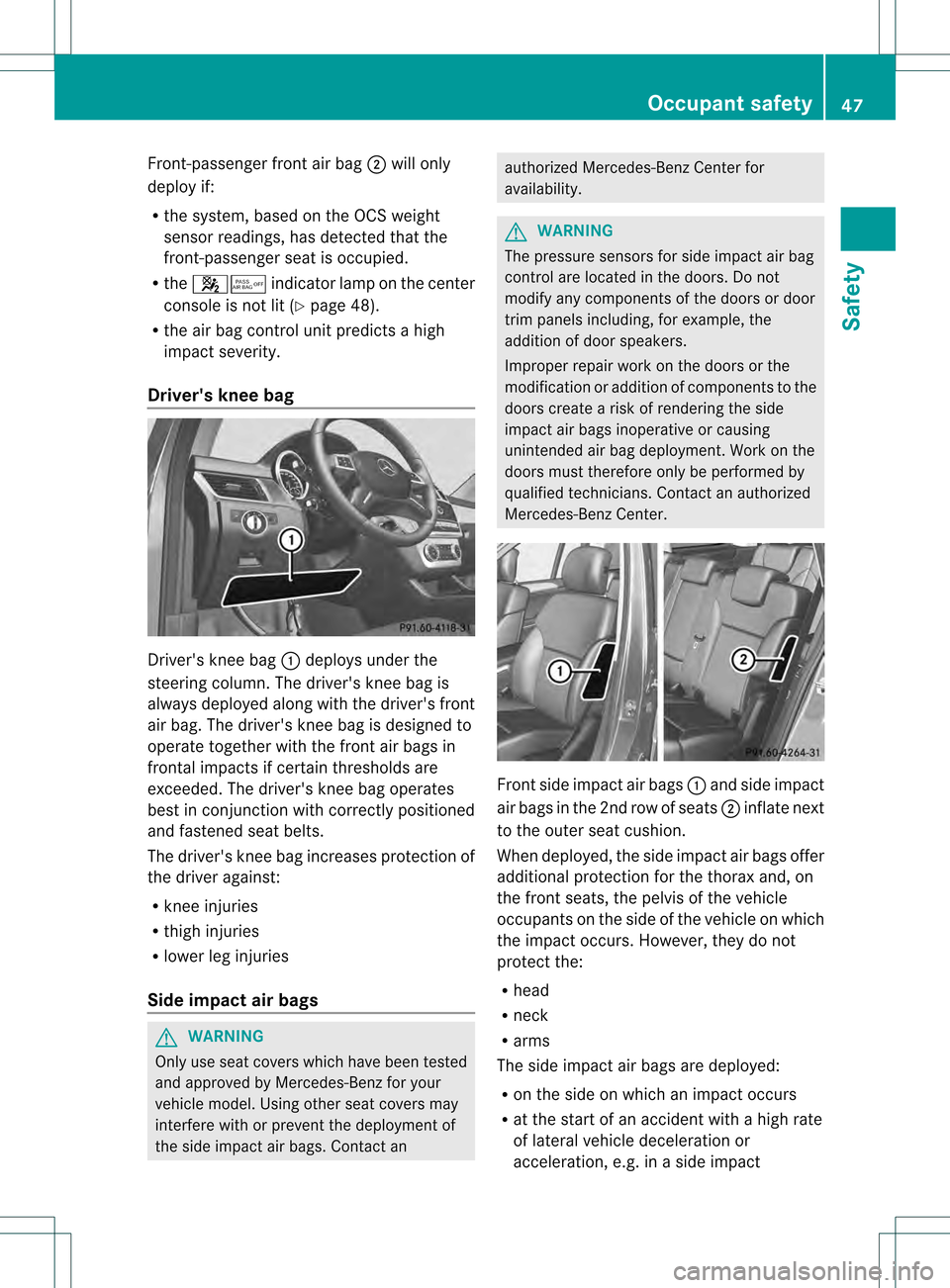
Front-passenger front air bag
0003will only
deploy if:
R the system, based on the OCS weight
senso rreadings, has detected that the
front-passenger seat is occupied.
R the 001A001C indicator lamp on the center
console is not lit (Y page 48).
R the air bag control unit predicts a high
impact severity.
Driver's knee bag Driver's knee bag
0002deploys under the
steering column. The driver's knee bag is
always deployed along with the driver's front
air bag. The driver's knee bag is designed to
operate together with the fron tair bags in
frontal impacts if certain thresholds are
exceeded. The driver's knee bag operates
best in conjunction with correctly positioned
and fastened seat belts.
The driver's knee bag increases protection of
the drive ragainst:
R knee injuries
R thigh injuries
R lower leg injuries
Side impact air bags G
WARNING
Only use seat covers which have been tested
and approved by Mercedes-Benz for your
vehicle model. Using other seat covers may
interfere with or prevent the deployment of
the side impact air bags. Contact an authorized Mercedes-Benz Center for
availability.
G
WARNING
The pressure sensors for side impact air bag
control are located in the doors. Do not
modify any components of the doors or door
trim panels including, for example, the
addition of door speakers.
Improper repair work on the doors or the
modification or addition of components to the
doors create a risk of rendering the side
impact air bags inoperative or causing
unintended air bag deployment. Work on the
doors must therefore only be performed by
qualified technicians. Contact an authorized
Mercedes-Benz Center. Fronts
ide impac tair bags 0002and side impact
air bags in the 2nd row of seats 0003inflate next
to the outer seat cushion.
When deployed, the side impac tair bags offer
additional protection for the thorax and, on
the front seats, the pelvis of the vehicle
occupants on the side of the vehicle on which
the impac toccurs .However, they do not
protect the:
R head
R neck
R arms
The side impact air bags are deployed:
R on the side on which an impact occurs
R at the start of an accident with a high rate
of lateral vehicle deceleration or
acceleration, e.g. in aside impact Occupant safety
47Safety Z
Page 50 of 454

R
regardless of whethe rthe seat belt on the
driver's seat and the outer seats of the 2nd
row of seats is used
R independently of the front air bags
R independently of the ETDs
If the vehicle rolls over, the side impact air
bags are generally not deployed. side impact
air bags are deployed if the system detects
high vehicle deceleration or acceleration in a
lateral direction, or also if the vehicle rolls
over, and the system determines that side
impact air bag deployment can offer
additional protection to that provided by the
seat belt.
Side impact air bags will not deploy in side
impacts which do not exceed the system's
preset deployment thresholds for lateral
acceleration/deceleration. You will then be
protected by the fastened seat belt.
The side impact air bag on the front-
passenger side is not deployed in the
following situations:
R the OCS system detects that the front-
passenger seat is not occupied, and
R the front-passenger seat belt is not
fastened.
The side impact air bag on the front-
passenger side will deploy if the front-
passenger seat belt is fastened, regardless of
whether the front-passenger seat is occupied
or not.
Window curtain air bags Window curtain air bags
0002enhance the level
of protection for the head, but not chest or
arms, of the vehicle occupants on the side of
the vehicle on which the impact occurs.
The window curtain air bags are integrated
into the side of the roof frame and deploy in
the area extending from the front door (A-
pillar) to the rear side window (D-pillar).
Window curtain air bags are deployed:
R at the start of an accident with a high rate
of lateral vehicle deceleration or
acceleration, e.g. in aside impact
R on the side on which an impac toccurs
R on the driver's side and passenger side, in
the event of a vehicle rollover and if the
system determines that ai rbag deployment
can offer the vehicle occupants additional
protection to that provided by the seat belt
R independently of the use of the seat belt
R regardless of whether the front-passenger
seat is occupied
R independently of the fron tair bags
Window curtain air bags 0002will not deploy in
the even tofimpacts which do not exceed the
system's preset deployment thresholds for
vehicle acceleration/deceleration. You will
then be protected by the fastened seat belt. Occupant Classification System
(OCS)
Method of operation G
WARNING
If the 001A001C indicator lamp illuminates
when an adult or someone larger than a small
individual is in the front passenger seat, have
the front passenger reposition himsel for
herself in the seat until the 001A001C
indicator lamp goes out.
In the event of a collision, the air bag control
unit will not allow front passenger front air bag
deployment when the OCS has classified the
front passenger seat occupant as weighing as
much as or less than a typical 12-month-old 48
Occupant safetySafety
Page 51 of 454
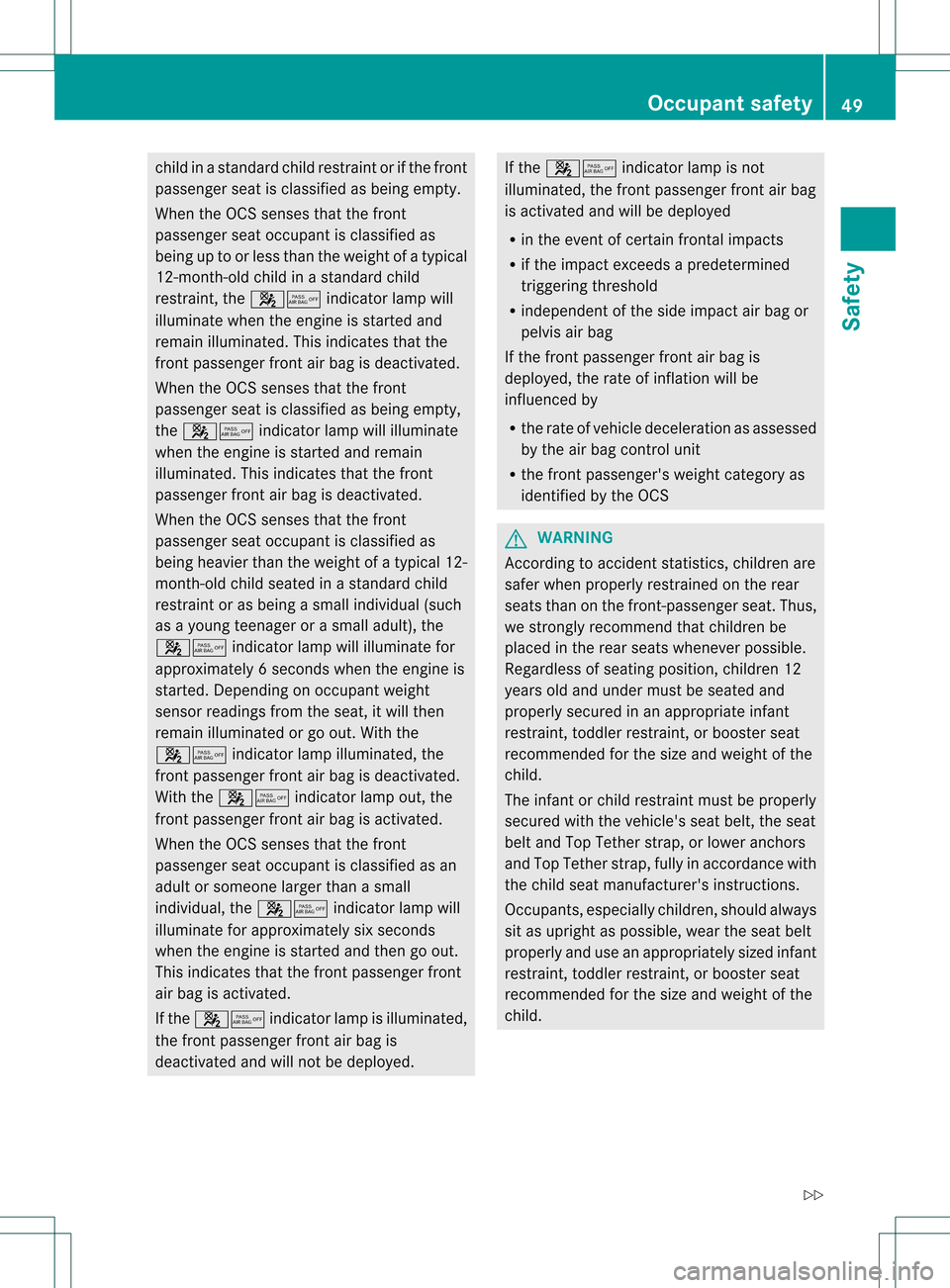
child in a standard child restraint or if the front
passenger sea
tis classified as being empty.
When the OCS senses that the front
passenger seat occupant is classified as
being up to or less than the weight of a typical
12-month-old child in a standard child
restraint, the 001A001Cindicator lamp will
illuminate when the engine is started and
remain illuminated. This indicates that the
front passenger front air bag is deactivated.
When the OCS senses that the front
passenger seat is classified as being empty,
the 001A001C indicator lamp will illuminate
when the engine is started and remain
illuminated. This indicates that the front
passenger front air bag is deactivated.
When the OCS senses that the front
passenger seat occupant is classified as
being heavier than the weight of a typical 12-
month-old child seated in astandard child
restraint or as being a small individual (such
as a young teenager or asmall adult), the
001A001C indicator lamp will illuminate for
approximately 6seconds when the engine is
started. Depending on occupant weight
sensor readings from the seat, it will then
remain illuminated or go out. With the
001A001C indicator lamp illuminated, the
fron tpassenger fron tair bag is deactivated.
With the 001A001C indicator lamp out, the
front passenger front air bag is activated.
When the OCS senses that the front
passenger seat occupant is classified as an
adult or someone larger than a small
individual, the 001A001Cindicator lamp will
illuminate for approximately six seconds
when the engine is started and the ngo out.
This indicates that the front passenger front
air bag is activated.
If the 001A001C indicator lamp is illuminated,
the front passenger front air bag is
deactivated and will not be deployed. If the
001A001C indicator lamp is not
illuminated, the front passenger front air bag
is activated and will be deployed
R in the event of certain frontal impacts
R if the impact exceeds a predetermined
triggering threshold
R independent of the side impact air bag or
pelvis air bag
If the front passenger front air bag is
deployed, the rate of inflation will be
influenced by
R the rate of vehicle deceleration as assessed
by the air bag control unit
R the front passenger's weight category as
identified by the OCS G
WARNING
According to accident statistics, children are
safer when properly restrained on the rear
seats than on the front-passenger seat. Thus,
we strongly recommend that children be
placed in the rear seats whenever possible.
Regardless of seating position, children 12
years old and under must be seated and
properly secured in an appropriate infant
restraint, toddler restraint, or booster seat
recommended for the size and weight of the
child.
The infant or child restraint must be properly
secured with the vehicle's seat belt, the seat
belt and Top Tether strap, or lower anchors
and Top Tether strap, fully in accordance with
the child seat manufacturer's instructions.
Occupants, especially children, should always
sit as upright as possible, wear the seat belt
properly and use an appropriately sized infant
restraint, toddler restraint, or booster seat
recommended for the size and weight of the
child. Occupant safety
49Safety
Z
Page 56 of 454
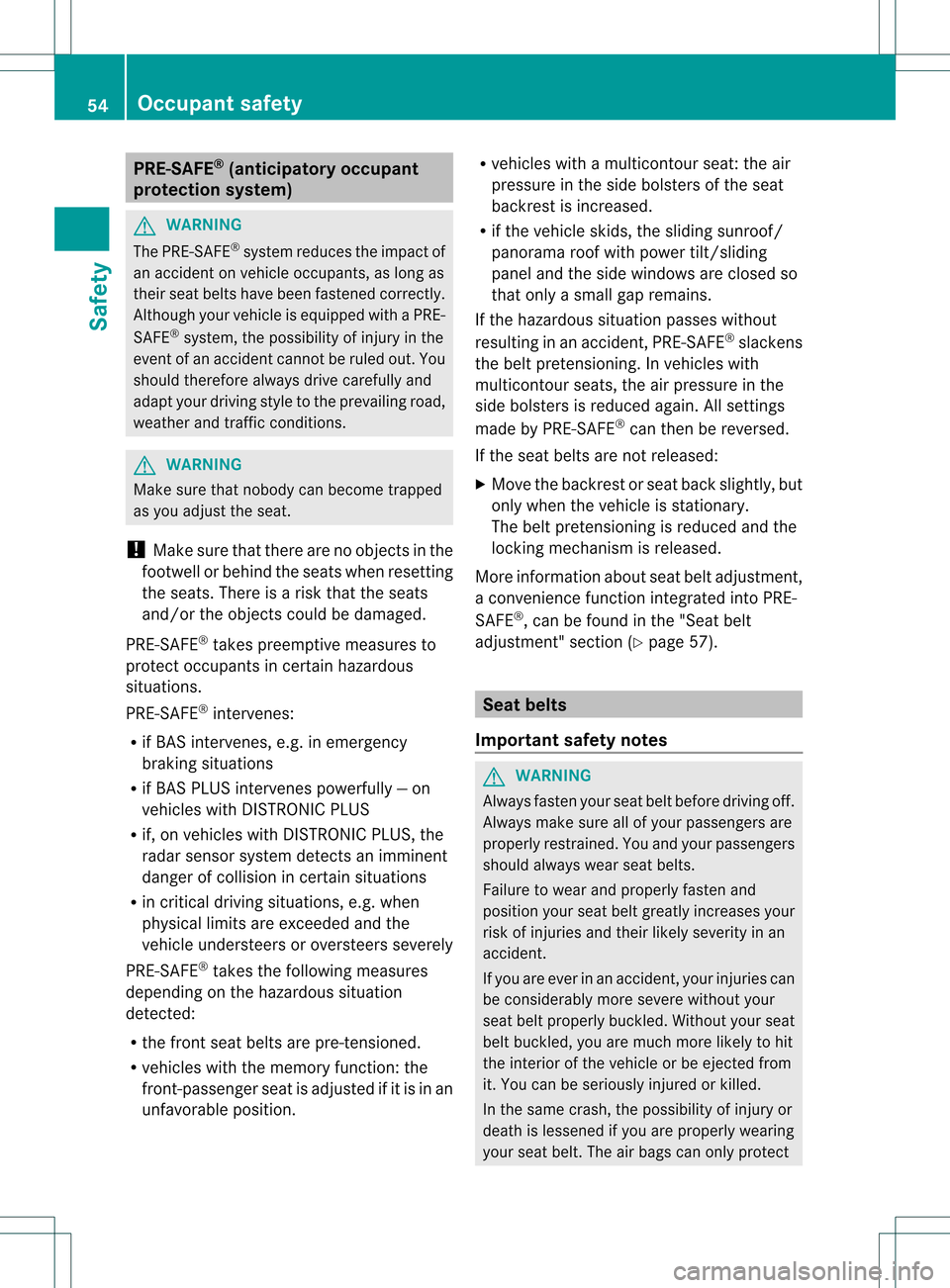
PRE-SAFE
®
(anticipatory occupant
protection system) G
WARNING
The PRE-SAFE ®
system reduces the impact of
an accident on vehicle occupants, as long as
their seat belts have been fastened correctly.
Although your vehicle is equipped with a PRE-
SAFE ®
system, the possibility of injury in the
event of an accident cannot be ruled out. You
should therefore always drive carefully and
adapt your driving style to the prevailing road,
weather and traffic conditions. G
WARNING
Make sure that nobody can become trapped
as you adjust the seat.
! Make sure that there are no objects in the
footwell or behind the seats when resetting
the seats. There is a risk that the seats
and/or the objects could be damaged.
PRE-SAFE ®
takes preemptive measures to
protect occupants in certain hazardous
situations.
PRE-SAFE ®
intervenes:
R if BAS intervenes, e.g. in emergency
braking situations
R if BAS PLUS intervenes powerfully — on
vehicles with DISTRONIC PLUS
R if, on vehicles with DISTRONIC PLUS, the
radar sensor system detectsani mminent
dange rofcollision in certain situations
R in critical driving situations, e.g. when
physical limits are exceeded and the
vehicle understeers or oversteers severely
PRE-SAFE ®
takes the following measures
depending on the hazardous situation
detected:
R the front seat belts are pre-tensioned.
R vehicles with the memory function: the
front-passenger seat is adjusted if it is in an
unfavorable position. R
vehicles with a multicontour seat: the air
pressure in the side bolsters of the seat
backrest is increased.
R if the vehicle skids, the sliding sunroof/
panorama roof with power tilt/sliding
panel and the side windows are closed so
that only a small gap remains.
If the hazardous situation passes without
resulting in an accident, PRE-SAFE ®
slackens
the belt pretensioning. In vehicles with
multicontour seats, the air pressure in the
side bolsters is reduced again. All settings
made by PRE-SAFE ®
can then be reversed.
If the seat belts are not released:
X Move the backrest or seat back slightly, but
only when the vehicle is stationary.
The belt pretensioning is reduced and the
locking mechanism is released.
More information about seat belt adjustment,
a convenience function integrated into PRE-
SAFE ®
, can be found in the "Seat belt
adjustment" section (Y page 57). Seat belts
Important safety notes G
WARNING
Always fasten your seat belt before driving off.
Always make sure all of your passengers are
properly restrained. You and your passengers
should always wear seat belts.
Failure to wear and properly fasten and
position your seat belt greatly increases your
risk of injuries and their likely severity in an
accident.
If you are ever in an accident, your injuries can
be considerably more severe without your
seat belt properly buckled. Without your seat
belt buckled, you are much more likely to hit
the interior of the vehicle or be ejected from
it. You can be seriously injured or killed.
In the same crash, the possibility of injury or
death is lessened if you are properly wearing
your seat belt. The air bags can only protect 54
Occupant safetySafety